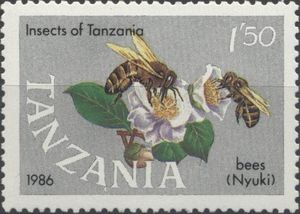The goal of this work was assess the toxic effects of thiamethoxam on newly emerged worker bees of Apis mellifera (africanized honeybee—AHB). Initially, we determined that the lethal concentration 50 (LC50) of thiamethoxam was 4.28 ng a.i./microliter of diet. To determine the lethal time 50 (LT50), a survival assay was conducted using diets containing sublethal doses of thiamethoxam equal to 1/10 and 1/100 of the LC50. The group of bees exposed to 1/10 of the LC50 had a 41.2% reduction of lifespan. When AHB samples were analyzed by morphological technique we found the presence of condensed cells in the mushroom bodies and optical lobes in exposed honeybees. Through Xylidine Ponceau technique, we found cells which stained more intensely in groups exposed to thiamethoxam. The digestive and regenerative cells of the midgut from exposed bees also showed morphological and histochemical alterations, like cytoplasm vacuolization, increased apocrine secretion and increased cell elimination. Thus, intoxication with a sublethal doses of thiamethoxam can cause impairment in the brain and midgut of AHB and contribute to the honeybee lifespan reduction. Using these data, the Spanish ecotoxicologist Francisco Sánchez-Bayo calculated that the toxicity of thiamethoxam to honey bees follows the Druckrey-Küpfmüller equation ctn = constant, where c = exposure concentration, t = median time to lethal effect, and n= time reinforcement exponent, always greater than 1. The actual value of n for thiamethoxam's toxicity to honey bees = 2.21 (r2=0.9, p<0.001). For imidacloprid, the actual value of n = 4.5.
Source:
Regiane Alves Oliveira, Thaisa Cristina Roat, Stephan Malfitano Carvalho, Osmar Malaspina
Environ Toxicol 00: 000–000, 2013 (attached)

- Log in to post comments

The toxicity of thiamethoxam is reinforced by exposure time
Oliviera's data indicate that the lethal effects of thiamethoxam on honey bees are reinforced by exposure time. Francisco Sánchez-Bayo calculated that the toxicity of thiamethoxam to honey bees follows the Druckrey-Küpfmüller equation ctn = constant, where c = exposure concentration, t = median time to lethal effect, and n= time reinforcement exponent, always greater than 1. The actual value of n for thiamethoxam's toxicity to honey bees = 2.21 (r2=0.9, p<0.001). For imidacloprid, the actual value of n = 4.5.